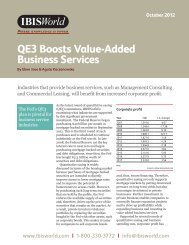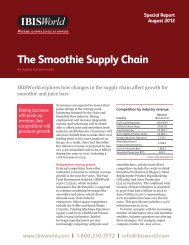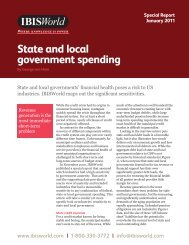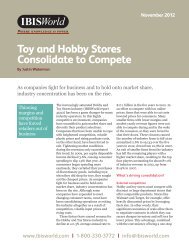Wedding Industry - IBISWorld
Wedding Industry - IBISWorld
Wedding Industry - IBISWorld
Create successful ePaper yourself
Turn your PDF publications into a flip-book with our unique Google optimized e-Paper software.
couple reached about $2,500 in 2008, up from less than<br />
$1,000 in 1999. More wedding photos are now being taken<br />
and purchased, while improved post-production services<br />
are a way to add value to increase revenue. This trend<br />
bodes well for lenders, but high photography skills, wordof-mouth<br />
recommendations, and project management ability<br />
are all required for a wedding photographer to succeed.<br />
Furthermore, photography is one of the highest discretionary<br />
areas within the wedding market. During tough times,<br />
many couples will turn to friends and family to produce<br />
the memories of their special day.<br />
<strong>Wedding</strong> Planners<br />
Planning a wedding can be very daunting for some couples<br />
and their families. For those who choose to hire a wedding<br />
planner, this expenditure can be one of the highest costs.<br />
Not all couples hire wedding planners, which increases the<br />
risk for this sector because it accounts for greater discretionary<br />
spending than many of the other wedding sectors. While<br />
only 2% of total wedding market revenue is derived from<br />
wedding planners, it can often be above 20% for individual<br />
weddings because a couple may hire a wedding planner to<br />
organize everything from A to Z.<br />
<strong>Wedding</strong> planners experience risks similar to those faced<br />
by other wedding sectors. After all, in arranging a wedding,<br />
the planner deals with every one of those industries. One of<br />
the biggest constraints for wedding planners is incorporating<br />
their markups on top of prices quoted by third parties.<br />
Successful wedding planners maintain strong relationships<br />
with a wide range of service providers, have a good reputation,<br />
and are able to provide unique solutions to meet<br />
individual client demands. Lenders must recognize these<br />
success factors and understand the financial responsibilities<br />
and liabilities involved when wedding planners are managing<br />
multiple service providers.<br />
The “Other” Category<br />
“Other” captures all the remaining items that a typical wedding<br />
includes. Some are more traditional purchases (invitations,<br />
reply cards, and rehearsal dinners), while others are<br />
more discretionary in nature (transportation and music).<br />
For nearly all of these services, there can be a high risk of<br />
product or service substitution, and an operator without<br />
significant recognition will experience low customer attainment<br />
and sales.<br />
Conclusion<br />
Ranging from accommodation and food services to retail,<br />
transportation, and professional services, the industries<br />
involved in organizing and carrying out a single wedding<br />
event are significant. For industries with a high revenue<br />
concentration associated with weddings (such as wedding<br />
planners and photographers), the success of their business<br />
is linked directly to the economic and social trends affecting<br />
wedding spending. For the many other service providers,<br />
wedding-related revenues are a key variable in business<br />
performance and profitability.<br />
For lenders to these businesses, the high level of competition<br />
and the ease of substitution among service providers<br />
pose additional business risks. Since getting repeat business<br />
from satisfied customers has its limits, the most successful<br />
operators benefit from consistently high word-of-mouth<br />
recommendations and referrals. Given the length of time<br />
from engagement announcement to wedding day, operators<br />
with a strong track record and well-established businesses<br />
will have a distinct advantage in generating and managing<br />
an order book consistent with their business capacity. v<br />
••<br />
Toon van Beeck and George Van Horn are senior analysts with <strong>IBISWorld</strong>. They can<br />
be reached at toonv@ibisworld.com and georgev@ibisworld.com.<br />
Call for Articles: Back to the Basics<br />
RMA Journal readers can’t get enough of “how<br />
to” articles that explain the basics of lending. And nobody<br />
writes those articles better than bankers. Please consider<br />
sharing your expertise by writing a “how to” feature, such<br />
as how to analyze cash flow, how to choose an appraiser,<br />
or how to prepare for a meeting with a potential customer.<br />
Do you have experience in lending to a particular<br />
niche? Other RMA members could benefit from your<br />
experience in lending to gas stations, churches, or spas.<br />
In this environment, almost everybody has experienced<br />
a loss on a credit that never should have been approved<br />
in the first place. Consider telling your tale in a Spilled<br />
Milk feature, using fictitious names for the customer (and<br />
even the bank). We can all learn from our mistakes.<br />
You don’t have to be a great writer. Just get the facts<br />
down in written form, and The RMA Journal editors will<br />
polish your prose while you put a shine on your career<br />
as a published author. Contact Journal editor Kathie<br />
Beans, kbeans@rmahq.org, with questions or an article<br />
proposal.<br />
The RMA Journal December 2010–January 2011 27














